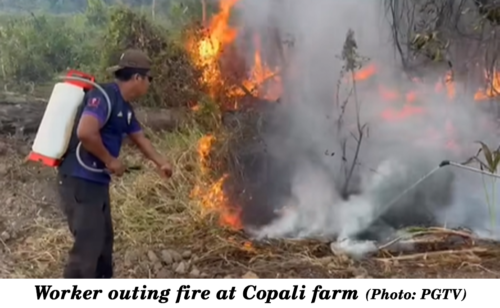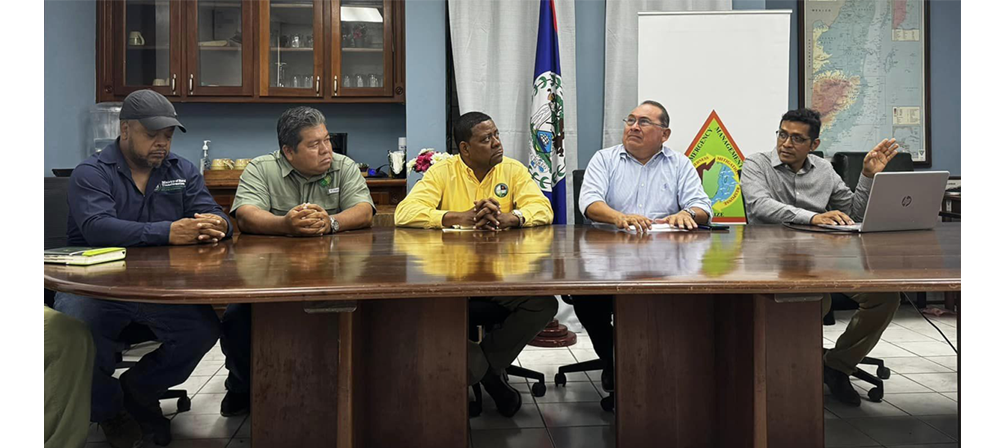Photo: Disaster Risk Management press conference with the media
by Kristen Ku
BELIZE CITY, Thurs. June 6, 2024
Since mid-May, the country has been severely impacted by widespread wildfires. These fires have not only devastated natural habitats, affecting flora and fauna, but also disrupted the lives of about 400 farmers. The fires have destroyed at least 10 homes, along with cattle and cultivated fields, which are the primary source of income for many of these farmers.
In response, the National Emergency Management Organization (NEMO) and government officials mobilized $500,000 in contingency funds to create emergency plans and provide humanitarian aid. However, several weeks have passed, and these fires still persists, particularly in the western and southern parts of the country.
In the southern region, villages such as Hicatee, Blue Creek, Silver Creek, San Miguel, Colombia, Big Falls, and recently, even the Copal Tree Farm have been particularly affected.

The fires reportedly originated in the Mennonite village of Pine Hill, spreading to the farm and destroying crops. On May 25, workers at the Copal Tree Farm were called back to put out the fire using backpack sprayers and machetes to clear the area.
Wil Maheia, an activist from the south, emphasized the need for better supervision during controlled burns. He noted, “At this time fire is still a threat to the entire Toledo District. There’s still smoke. Whenever there’s smoke, there’s a chance that there will be fire again, because all it takes is for the wind to pick up. And once the wind picks up, then there’s a good chance that the fire will start again.”
In the west, fires have ravaged areas like Benque Viejo Town and the Mountain Pine Ridge, affecting 10,000 hectares (34,000 acres) of forest. Reports estimate the damages to be over $8 million in value, though the full impact on agriculture remains unassessed due to the ongoing fires and persistent hot, dry weather.
“Unprecedented fires are appearing in parts of our country where they have never been an issue [before], spreading rapidly in paths of destruction. As we speak, communities in Toledo and Cayo, alongside the BDF and other partners [are in] the fields continuing the battle against an unforgiving enemy which threatens to consume their homes and livelihoods. Simply put – fires have engulfed Belize …,” shared Minister of Blue Economy and Disaster Risk Management, Hon. Andre Perez in the House of Representatives last Thursday.
Recently, the Association of Protected Areas Management Organizations (APAMO) also reported preliminary damages of about $2 million due to fires in the Tapir Mountain Nature Reserve, behind Teakettle Village in the Cayo District. Executive Director Jose Perez mentioned a fire that extended into the park last week, which was only put out over the weekend.
However, another fire has since started, threatening the ranger station of the Belize Karst Habitat Conservation. This fire, also started by a Mennonite [farmer] on an unattended plot, has now destroyed over 100 acres.
“Definitely, more help is needed; and again, this is a crisis. I think we did not prepare; we did not plan well. This is something that happens every year. Along with the respective government entities, I’m hoping that we don’t go through this again next year. I mean, it’s millions of dollars that are being lost in flora and fauna; but also, what is at risk right now is actually infrastructure. We would have been in a better place if these fires could have been prevented,” Perez said.
Today, the Ministry of Disaster Risk Management (MDRM) and a multi-agency task force held a press conference in Belize City to update the public on the fire response efforts. Various operations have been conducted throughout the country by different entities, including:
- The Ministry of Infrastructure, Development, and Housing (MIDH): Three workmen have been deployed to the Mountain Pine Ridge area, as well as a D6 bulldozer, and a support vehicle to clear 28 miles of firebreaks over two weeks. The Tapir Mountain Reserve has also received a team of three operators and a D6 bulldozer, along with a private bulldozer which they are operating for four days to support firefighting efforts. Additionally, in the Toledo District there is a water truck deployed to assist with fire response in villages, providing crucial water supplies needed for firefighting due to low rainfall.
- Belize Defence Force: They conducted 19 deployments in the south, supporting humanitarian assistance and fire operations with 49 soldiers on a rotational basis. In the west, they had 11 deployments with 18 soldiers, also assisting NEMO with air reconnaissance flights.
- National Fire Service: They provided firefighting support across the Toledo District and responded to 1,231 bushfire incidents nationwide from March to May.
- Belize Red Cross: Mobilized 62 volunteers, providing first aid, meals, and psychosocial support to affected communities, and assisting with damage assessment and relief efforts.
- NEMO: Provided essential supplies such as mattresses, food, water, hygiene kits, and stoves to affected families in Blue Creek Village and Graham Creek area.
- Astrum Helicopters: Conducted four missions, dropping a total of 99,000 gallons of water on fires in various reserves and assisting with reconnaissance.
Regional and international partners also played crucial roles such as the Caribbean Disaster Emergency Management Agency, which activated support mechanisms, and the European Union’s Copernicus satellite that provided valuable imagery. The US Forest Service also offered training and firefighting equipment, while local NGOs facilitated additional firefighting support.
And in the midst of all of this, all that most farmers are praying for is for some rain, especially as we entered the official Atlantic Hurricane Season on June 1. Some light showers last week were insufficient to significantly impact the fires.
“We had a bit of showers towards the end of last week, but it was certainly not enough,” Chief Meteorologist, Ronald Gordon, told Amandala. “We are monitoring very closely and looking at each model run to see if it persists; but looking at the forecast, we are going to have an increase in showers, even thunderstorms, going into late Thursday into Friday. So that’s some good news. However, we need to monitor closer to ensure that it is not excessive, and then we go in the other direction of flooding.”
If flooding does occur, come next year, the dry season could be worse, with double the forest fires occurring. The Ministry of Disaster Risk Management says they have already started planning. “Climate change is real. That is something that we have to be really, really aware of. It’s planning. It’s not only about fighting and doing something for today, but we have to plan for tomorrow as well. That is the learning lesson that we’re having here today,” Minister Perez said.
The conference also touched on the fact that many of these bushfires are human-induced incidents. That means that the government can enforce a stop order, prohibiting agricultural burning during the dry season. However, Minister Perez says it isn’t that simple.
“We have to look at the bigger picture. It’s impossible to say a stop order. We’re talking about the north, working farmers, that’s how they traditionally have been doing things, to burn their cane so that it can be taken off to the factories; and the traditional slash and burn down south, that is done. It’s the time around when the farmers are preparing their lands in preparation for the rains that are coming. Looking for the future, we certainly have to look at alternatives in terms of education; and not only that, but providing alternatives by way of the agricultural department [on] how to best deal with preparing the land,” he explained.

